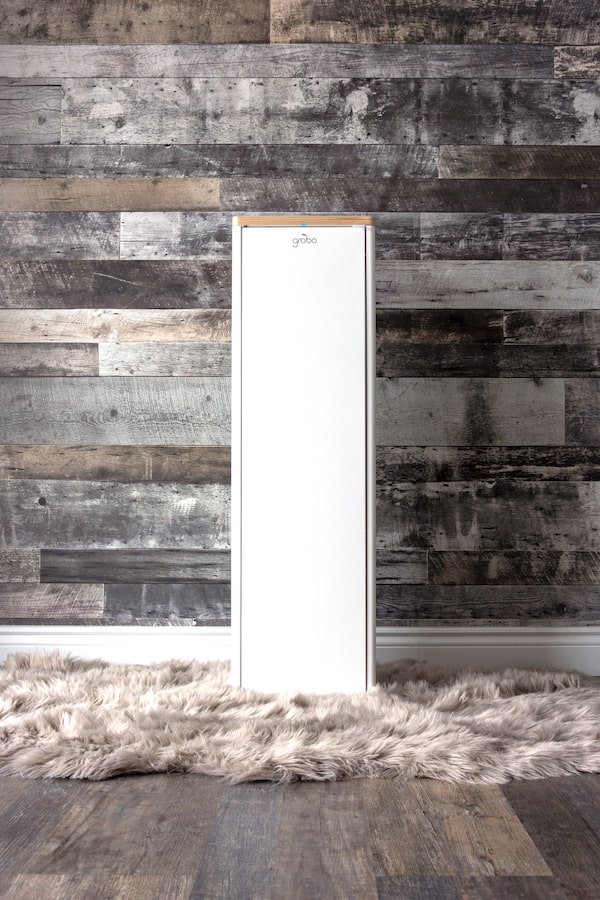Growing your own cannabis is legal, but Grobo is hoping new technology will make the practice more popular.
The Waterloo, Ont.-based company sells automated, smell-proof and smartphone-connected growing cabinets designed to cultivate exactly one plant at a time. It takes between two and four months – depending on whether users plant from seed or clone – to harvest between 42 and 84 grams of dried cannabis flower, CEO and co-founder Bjorn Dawson told Cannabis Professional in an interview.
“As you grow, the only real thing that you absolutely have to do is change out the water every week,” Mr. Dawson said. “The ability to simply add water and the system will figure out if you have tap water, distilled water, reserve osmosis water, whether it is hard or soft and will automatically adjust the water for you and add nutrients. Then every hour it is balancing your Ph levels. That is really something that is not possible if you’re just a regular grower.”
Privately funded Grobo is looking to triple its 2018 revenue this year. Below, in Mr. Dawson’s own words – lightly edited for length and clarity – he explains the origins of the innovation behind Grobo, its potential and the challenges it faces.
Origin
We officially started the company in 2014 but it really goes back to 2013. I was trying to grow fruits and vegetables outside and having very little success. That year I harvested buckets and buckets of green tomatoes and actually laid them around the house trying to get them to turn red. That is where it started, just trying to grow fruits and vegetables at home.
We tried that for almost two years before we realized that cannabis was going to be really up and coming, the Liberals had been elected, legalization was being discussed and actually, the biggest thing was that a ton of customers, especially medical patients here in Canada, were asking us if we could help them grow their cannabis.
Their only options were grow tents, so we started to alter our systems to make it larger and capable of growing cannabis. That would have been late 2015, early 2016 when we would have made that switch.
Our other system, the first system we were developing, we had planned to sell for $200, but even then, you need to grow 200 heads of lettuce to pay for a $200 system, so the return on your investment isn’t there if you’re just growing herbs and vegetables. Then you go to the cannabis plant and suddenly you can have everything paid for within a year and a half, including your power and everything else. [EDS NOTE: Grobo pricing starts at $2,637.35 before taxes] We also had to boost the price, as it requires a lot more technology and monitoring and automation than growing anything else.
/www.theglobeandmail.com/files/dev/containers/tgam-th-cannabis-leaves.jpg)
Potential
We view this market as worth at least $3-billion, if you just look at Scotts Miracle Gro, they have Hawthrone and almost half a billion dollars invested in that, but really the way we look at it is that a lot of the stats are still hard to figure out. The average that we have seen is about 10 per cent of cannabis consumers home-grow already, I’ve seen studies as low as 4- to 6 per cent up to between 14- and 16 per cent. It is a big range. Home growing is generally an under-reported thing, whether it is legal or not.
Although it is about 10 per cent today, we actually believe we can open up the market and increase it significantly, by making growing something that is actually accessible to someone who has never done it before
We haven’t really said how [revenue] has gone, but I can tell you we are still not catching up to demand. The demand is really good, it is there. We are still almost a month behind on delivery.
If you had asked me [about our growth potential] at the end of last week, I would have said that we could maybe three times our revenue this year over last year, but if you’re asking me today, I think we could do even better.

Grobo solid automated growing boxHandout
Challenges
We are about 90 per cent U.S., although I think Canada will become a bigger and bigger percentage of our sales.
We used to do [manufacturing] here [in Canada] but the reality is, because most of our customers are in the United States, the border is just getting more and more difficult to cross with different goods, so it just made sense to move all of our production down there, that way we are not moving millions of dollars of product across the border every year. It was just working to de-risk our business.
There is also a group of incumbents that have been around for a long time. They are grow boxes that don’t necessarily have that automation piece, that would include Super Closest, or B.C. Northern Lights is another good one that Aurora Cannabis actually bought into [ED NOTE: Aurora paid nearly $10-million in Oct. 2017 for the parent company of B.C. Northern Lights] and they are starting to get a little bit more of that automation. I was talking to someone from their team and they said they had to build an app now because we exist.
 Jameson Berkow
Jameson Berkow